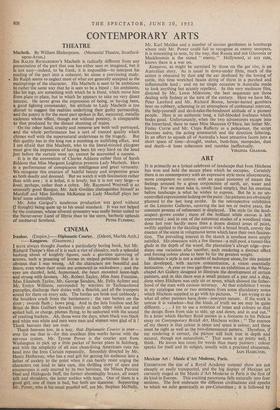ART
IT is primarily as a lyrical celebrant of landscape that Ivon Hitchens has won and held the secure place which he occupies. Certainly there is no contemporary, with an expressive style more idiosyncratic, more competent to convey with an equal economy of means the feelings aroused by a given conjunction of earth, air, water and leaves. For we must take it, surely (and simply), that his emotion before landscape is what he wishes to express. But he is no un- controlled expressionist lashing on the paint : his pictures are obviously planned to the last long stroke. In the retrospective exhibition at the Leicester Galleries, covering the last ten or twelve years, the constant process of refinement is displayed. The style (in the land- scapes) grows cooler ; more of the brilliant white canvas is left uncovered ; and in one of the autumnal studies of a woodland vista done last year hardly more than a dozen distinct areas of paint, swiftly applied to the dazzling canvas with a broad brush, convey the essence of the scene in voluptuous terms which have their own fascina- tion. The prevailing interest in the sketch is nowhere more amply satisfied. His obsession with a few themes—a mill-pool, a tunnel-like glade in the depth of the wood, the plantation's abrupt edge—pro- duces one variation after another, each rendering a distinct effect and forcing colour alone to bear by far the greatest weight. Hitchens's style is not a matter of technique alone, for this painter has developed, with narrow concentration, a vision essentially instinctive. A year or two ago there was an exhibition at the White- chapel Art Gallery designed to illustrate the development of certain painters, and in this there was a small picture of a pier and a ship, done when Hitchens was only six or seven, which showed the father- hood of the man with curious accuracy. At that exhibition I wrote in my catalogue one or two sentences from some elucidatory notes which Hitchens supplied to go with his pictures. " I am trying to do what all other painters have, done—interpret nature. If the work is untrue it is valueless—but the kinds, of truth we see may be quite different. . . . I try to use a notation of tones and colours so that the design flows from side to side, up and down, and in and out." In a letter which Herbert Read quotes in a footnote to his Pelican essay on Contemporary British Art, Hitchens writes : " The essence of my theory is that colour is space and space is colour, and these must be right as well as the two-dimensional, pattern. Therefore, if my rendering is correct, the picture will look true in depth and natural, though not naturalistic." That sums it up pretty well, I think. He leaves less room for words than many painters : colour speaks for itself and its subject, usually with a practised eloquence.
LAIN HAMILTON.


















































 Previous page
Previous page